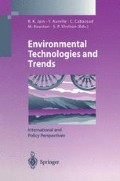Abstract
Adsorption of polluted solutions is performed by different kinds of activated carbon: grains, powder and fibers (cloth or felt). The adsorption is determined in batch reactor. Classic models are applied and kinetic constants are calculated. Results showed that performance of fibrous activated carbon (FAC) is significantly better than that of granular activated carbon (GAC), and is quite similar to that of powder activated carbon (PAC). Moreover, the adsorption capacities for phenol of FAC is markedly greater than GAC. Therefore the application of FAC adsorbers may lead to smaller adsorption reactors. The breakthrough curves obtained with FAC adsorbers are particularly steep, suggesting a smaller mass transfer resistance than for the GAC. The adsorption zone in the FAC bed is about 3.4 mm and is not dependent on the flow rate for the range 0.67–2.07 m • h-1.
Access this chapter
Tax calculation will be finalised at checkout
Purchases are for personal use only
Preview
Unable to display preview. Download preview PDF.
References
Abe M, Kaneko Y, Agui W and K Ogino (1992) removal of humic substances dissolved in water with carbonaceous adsorbents. Sci Tot Environ, 117/118, 551–559
Adham SS, Snoeyink VL, Clark MM and Bersillon J-L (1991) Predicting and verifying organics removal by PAC in an ultrafiltration system. J Am Wat Works Ass 83, 12, 81–91
Adham SS, Snoeyink VL, Clark MM and Anselme C (1993) Predicting and verifying TOC removal by PAC in pilot-scale OF systems. J Am Wat Works ASS 85, 12, 58–68
Anselme C, Chevalier MR, Mazounie P and Mallevialle J (1992) Applications industrielles de l’ultrafiltration pour la production d’eau potable - Bilan de fonctionnement des installations - Perspectives d’évolution. Tech Sci Municip-L’Eau, 87, 9, 403–408
Baldauf G. (1993) Removal of pesticides in drinking water treatment. Acta Hydrochim Hydrobiol 21,4, 203–208
Bansal RC, Donnet JB, Stoeckli N (1998) Active Carbon, Marcel Dekker Inc, NY, USA
Baudu M, Le Cloirec P, and Martin G (1990) Caractéristiques et performances des fibres de charbon actif - Applications au traitement d’eau. Tech Sci Municip-L’Eau 85, 12, 621–625
Baudu M, Le Cloirec P, and Martin G (1991) Pollutant adsorption onto activated carbon membranes. Wat Sci Technol 23, 1659–1666
Cheremisinoff P.M., Ellerbush F (1978) Carbon adsorption Handbook, Ann Arbor Sci, Ann Arbor Mi, USA
Clark MK, and Lykins BW (1989) Control of trihalomethane and synthetic organics. In RM Clark (Ed), Granular activated carbon - Design, operation and cost. Lewis Publisher, Michigan, pp 257–293
Hutchins R (1973) New method simplifies design of activated carbon systems - Water bed-depth service time analysis. Chem Eng 20, 133–138
Le Cloirec P, Baudu M and Martin G (1990a) European Patent
Le Cloirec P, Baudu M, Martin G, Dagois G (1990b), Membrane, toiles, fibres ou feutres: des charbons actifs d’utilisations prometteuses, Rev Sci Tech Défense 2, 111–123
Le Cloirec P, and Delanghe B (1994) Ultrafiltration-Fibres de charbon actif - Dispositif de mise en oeuvre, et composites. French patent n° 9411625
Seung-Kon Ryu (1990) Porosity of activated carbon fibre. High Temp- High Pressures 22, 345–354
Schulhof R. (1979) An evaluating approach to activated carbon treatment, J Am Water Works Ass 71, 648–661
Suzuki M (1991) Application of fiber adsorbents in water treatment. Wat Sci Technol 23, 1649–1658
Tse-Hao Ko, Chiranairadul P, Chung-Hua Lin (1992) The study of polyacrylonitrile-based activated carbon fibres for water purification: Part I. J Materials Sci Letters 11, 6–8
Weber WJ, and Smith EH (1987) Simulation and design models for adsorption processes. Environ Sci Technol 21, 11, 1040–1050
Xing B, McGill WB, Dudas MJ, Maham Y, and Hepler L (1994) Sorption of phenol by selected bio-polymers: isotherms, energetics, and polarity. Environ Sci Technol 28, 466–473
Editor information
Editors and Affiliations
Rights and permissions
Copyright information
© 1997 Springer-Verlag Berlin Heidelberg
About this chapter
Cite this chapter
Delanghe, B., Mercier, L., Le Cloirec, P. (1997). Adsorption of Organic Micropollutants onto Activated Carbon Fibers: Cloth and Felt. In: Jain, R.K., Aurelle, Y., Cabassud, C., Roustan, M., Shelton, S.P. (eds) Environmental Technologies and Trends. Environmental Engineering. Springer, Berlin, Heidelberg. https://doi.org/10.1007/978-3-642-59235-5_3
Download citation
DOI: https://doi.org/10.1007/978-3-642-59235-5_3
Publisher Name: Springer, Berlin, Heidelberg
Print ISBN: 978-3-642-63913-5
Online ISBN: 978-3-642-59235-5
eBook Packages: Springer Book Archive

